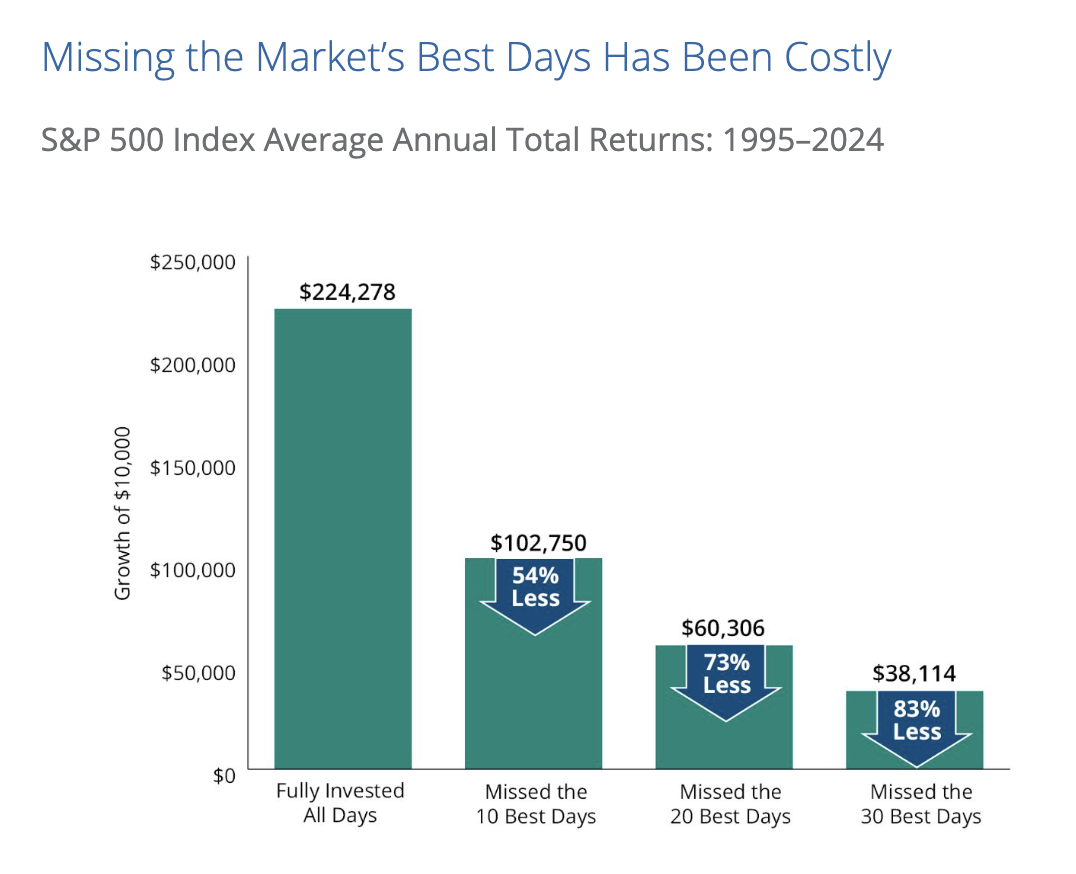
Financial Foundation #7 - Investing
What is “timing the market?”
"Timing the market" is the strategy of trying to pull your money out of stocks right before they drop and jumping back in just before they soar. Think of it like trying to perfectly time catching a wave when you're surfing. If you get it just right, you get a great ride and feel like a champion. But if you mistime it—and it's incredibly easy to mistime it—you either miss the wave completely or get spectacularly wiped out. In retirement, a "wipeout" with your nest egg is a lot less fun than getting a belly full of saltwater.
Why Market Timing Doesn’t Work
The appeal is understandable. You've spent decades building your savings, and the last thing you want is to see a market downturn take a big bite out of it. It seems logical to try and sidestep the drops. If you could sell at the peak and buy back at the bottom, you could essentially give yourself a raise in retirement.
The problem is, no one has a reliable crystal ball. The market is notoriously fickle. Getting out of the market may feel like the easy part; the real challenge is knowing when to paddle back out. Often, by the time it feels "safe" to reinvest, the best part of the wave has already passed, and you've missed out on the gains. And unfortunately, they don’t ring a giant bell to announce the market has bottomed out.
Why It's Especially Dangerous in Retirement
For a younger investor, a big market drop is a bummer, but they have decades to recover. For a retiree, the stakes are much higher. Trying to time the market when you're living off your investments is like trying to surf in a hurricane—one wrong move, and you can get tossed against the rocks. Here’s why it's so risky now:
You Have Less Time for a "Do-Over": Your working years are over, so you can't rely on a paycheck to rebuild your savings if you make a bad call. If you sell low and lock in your losses, that money is gone for good.
Missing the Best Days Is Devastating: A huge portion of the market's long-term gains often happens in just a few, very powerful recovery days. If you're sitting on the sidelines on the beach, you miss that crucial rebound your portfolio needs to last throughout your retirement. It’s like leaving the party right before they bring out the cake (see the chart below).
The "Oops, I Sold at the Bottom" Nightmare: The biggest danger is panicking during a downturn and selling your investments. You've just turned a temporary paper loss into a permanent real-life loss right when you need that money the most.
Past performance does not guarantee future results. For illustrative purposes only. Data Sources: Ned Davis Research, Morningstar, and Hartford Funds, 1/25.
Stay the Course
Instead of becoming a stressed-out day trader, a more prudent strategy in retirement is to have a well-balanced, diversified portfolio that aligns with your risk tolerance and goals. This means having a mix of investments (like stocks and bonds) in the right balance so you can be comfortable with the amount of risk you are taking
This approach lets you weather the storms without having to make drastic moves. You can draw the income you need while leaving the bulk of your investments to grow over the long term. It’s less about timing the market and more about having a solid plan that lets you sleep at night, which, let's be honest, is one of the best perks of retirement. Leave the big-wave surfing to the kids; you've earned the right to relax on the shore.
Actionable Steps to Avoid the Timing Trap
Here are a few simple things you can do to protect your portfolio without trying to predict the future.
Review Your Investment Mix. Take a look at your portfolio's allocation between stocks, bonds, and other assets. As you get older, it is common to see a gradual shift toward a more conservative mix (more bonds, less stock) to reduce volatility. However, your specific situation should be the driver of your investment mix - not what the guy at the water cooler might be doing. Your goal is to have a portfolio that lets you participate in growth but doesn't feel like a wild roller coaster.
Build a Cash Buffer. Consider keeping one to three years' worth of living expenses in a safe, easily accessible account like a high-yield savings account or a money market fund. This is your "spending bucket." When the market takes a dive, you can live off this cash instead of being forced to sell your stocks at the worst possible time.
Automate Your Plan. Set up automatic, regular withdrawals from your investment accounts to your checking account. This creates a disciplined "paycheck" for yourself and helps prevent emotional decisions. It forces you to stick to your plan rather than pulling out a huge chunk of money because of a scary headline.
Talk to a Professional. You don't have to manage this alone. Consider meeting with a fiduciary financial advisor. A fiduciary is legally obligated to act in your best interest. They can help you create a sound withdrawal strategy and act as a calm, rational voice when the market gets choppy.
Need a review of your current investment mix to make sure it aligns with your long term goals? Or have you pulled out of the market and not sure how to get back in? We’re here to help. We’ll review your current plan and give you a few high level recommendations, even if you don’t become a client.


